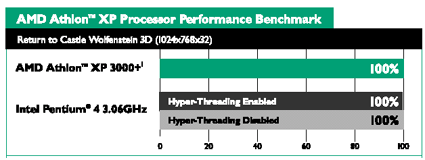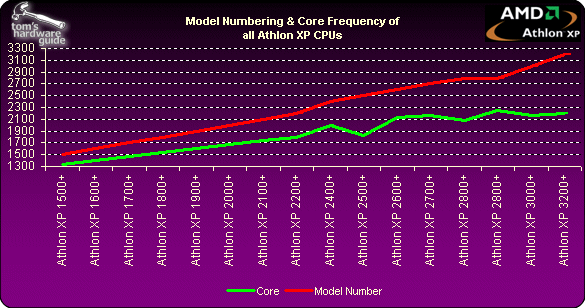High-Flying: AMD Athlon XP 3200+ Squares Off Against Intel P4 3 GHz
Obscure Model Numbering
For AMD, it appears that the emphasis on model numbering has created a fog around the reality. For example, the old Thunderbird Athlon 1400 (also known as the block heater) is tested with 37 somewhat obsolete benchmarks (up to four years old) and voilà! You have the basis for the performance rating here on AMD's own site.
The model numbering comprises Office Productivity (Winstone 2001, Winstone 2002, Sysmark 2001), Digital Media (Winstone 2001, Winstone 2002, Sysmark 2001) and 3D Gaming (Aquamark, Dronez, Evolva, Expendable, Half-Life, MDK2, Quake III, RTCW, Serious Sam, Unreal Tournament, Winbench 2000 and 3D Mark 2001).
However, AMD changes the Sysmark 2001 benchmark by exchanging a file for the media player. The portfolio contains some games that are - let's be honest - just plain unpopular (Evolva, Expendable, MDK2) or based on antiquated engines (Halflife).

We've set up three charts in order to explore the connection between model number and actual clock speed. In the first diagram, you'll see two lines. The red one represents the model numberings, and the green one the clock speed of the individual CPUs. Between the Athlon XP 1500+ and the XP 2200+, the difference remains fairly constant. As the processors evolve, you can clearly see that the model numbering and clock speed diverge more and more from one another. The reasons for this are the raised front side bus (166 MHz or, later, 200 MHz) and the increase in the L2 cache from 256 kB to 512 kB.


The second chart shows the percentage change in clock speeds in the order in which the model numbers were allocated. You can clearly see the dip in clock speed for the Athlon XP 2500+, 2800+ and 3000+ because of the increase in the L2 cache. The last jump in the chart goes to the 2800+, which was only available as a press sample (with a small L2 cache). We discussed this CPU in greater detail in AMD Travels Through Time: Athlon XP 2800+ with Dual-DDR .
Stay on the Cutting Edge
Join the experts who read Tom's Hardware for the inside track on enthusiast PC tech news — and have for over 25 years. We'll send breaking news and in-depth reviews of CPUs, GPUs, AI, maker hardware and more straight to your inbox.
Current page: Obscure Model Numbering
Prev Page Memory Lane: History Of All The AMD And Intel CPUs Next Page Obscure Model Numbering, ContinuedMost Popular

